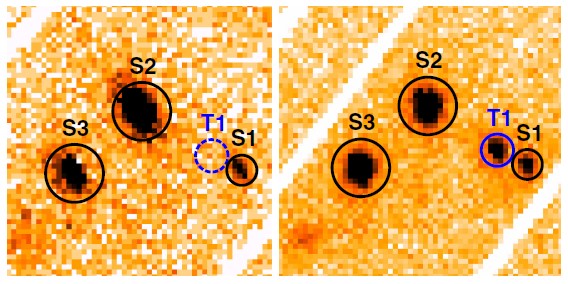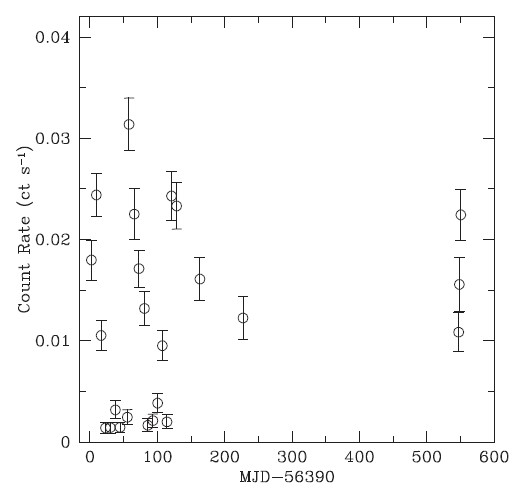Our Milky Way Galaxy is not alone in space. There are a number of smaller satellite galaxies which orbit around it. In the southern hemisphere, one can easily see two of our closest neighbours without a telescope, which are the well-known Large and Small Magellanic Clouds, about 160,000--200,000 light years away from us. What these satellite galaxies consist of and how they were formed is an interesting research topic.
Recently, researchers in SHAO, Dr. Jithesh Vadakkumthani, CAS PIFI Post-doctoral Fellow, and his supervisor Prof. Wang Zhongxiang have studied such a galaxy called NGC 55 at X-rays. Based on the data taken with Chandra and XMM-Newton X-ray telescopes, they found 15 candidate transient X-ray sources within the galaxy and studied what these transients could be. This work has recently been accepted for publication in the Astrophysical Journal.

ESA's XMM Newton Observatory images taken in 2001 and 2010 are shown in the left and right respectively. Three bright sources, marked as S1, S2 and S3, were detected in both images. A bright transient source, (marked as T1), appeared only in the 2010 image.
Dr. Jithesh said, “Since this galaxy is relatively far away from us, actually more than 30 times that of the Magellanic Clouds, we have used the observations conducted with the most sensitive international X-ray telescopes and identified the transient X-ray source population.” He further explained, such transient sources are often binaries consisting of a compact star as the primary, for example a black hole, and a normal star as the companion. The compact star accretes material from the companion star and radiate X-ray photons. Due to unstable accretion activities, the X-ray flux is variable. An X-ray variable can suddenly become very bright by several orders of magnitude in flux in the sky and then gradually decay to some level that can even be invisible. X-ray transients in our Milky Way have relatively been well studied, but those in other galaxies are not.

X-ray measurements of the transient source T1, showing that the source varied strongly over a 600 day period.
“Checking the X-ray data over 10 years, we found a group of 15 variables in NGC 55. We suggested that most of the transients are likely the typical X-ray binaries that commonly exist in our Milky Way.” Prof. Wang said, “From optical observations of NGC 55 and the Magellanic Clouds,
property similarities have been found between them. Now our results have further shown that they also share similarities in terms of X-ray sources and transients.”
Link to the research paper:
http://adsabs.harvard.edu/cgi-bin/bib_query?arXiv:1602.07381
http://adsabs.harvard.edu/abs/2015MNRAS.448.1973J contact
Science:
Jithesh Vadakkumthani, Shanghai Astronomical Observatory, jithesh@shao.ac.cn Zhongxiang, Shanghai Astronomical Observatory, wangzx@shao.ac.cn contact: wenwenzuo@shao.ac.cn, Shanghai Astronomical Observatory, 347
Wang
News75125